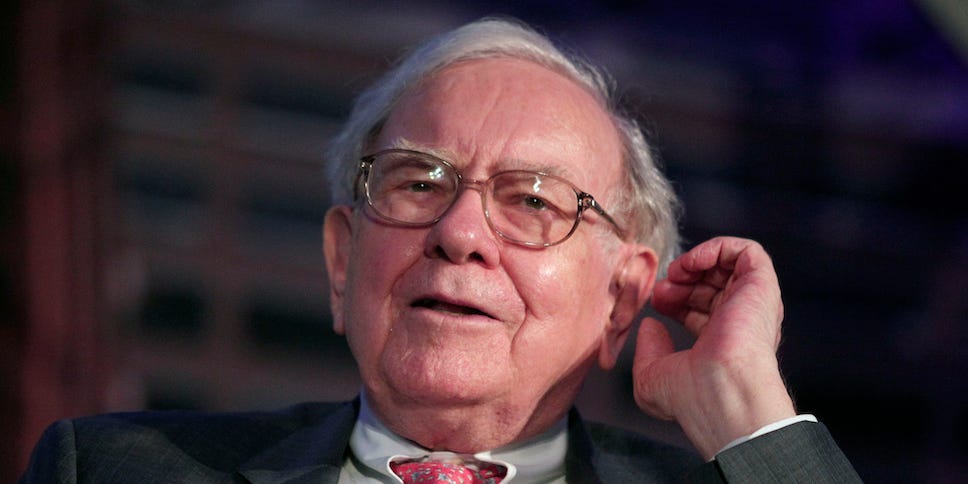- Warren Buffett is the billionaire boss of one of America’s biggest companies.
- Yet Berkshire Hathaway’s website looks like it was built in the 1990s and hasn’t been updated since.
- The antiquated website reflects Buffett’s values of simplicity, efficiency, and frugality.
Warren Buffett is one of the world’s wealthiest people with a net worth of $144 billion, and his Berkshire Hathaway conglomerate is worth about $1 trillion. Yet you could never guess that from its website, which looks like a relic from the early days of the internet.
The landing page of America’s seventh-largest public company — which generates over $350 billion of annual revenue and employs about 400,000 people — is little more than a list of hyperlinks on a white background.
Berkshire’s “Official Home Page” also features its name and address, a text ad for Geico car insurance, and an invitation to submit feedback by snail mail to headquarters — with a warning the staff is too small to write back.
Business Insider
Frankly, the website looks like a teenager slapped it together in the 1990s, and hasn’t returned since. But it does get updated at least every three months with earnings reports, and occasionally Buffett will decide something warrants a fresh link on the homepage, such as his clarification about Berkshire’s investment in Activision Blizzard in 2021.
Why has Buffett, who cares deeply about Berkshire’s public appearance and reputation, never updated his company’s antiquated website? He may see it as symbolic of Berkshire’s culture.
“Berkshire Hathaway’s bare-bones website reflects Buffett’s belief in frugality and decentralization. With a small team in Omaha, it prioritizes efficiency over extravagance,” Lawrence Cunningham, the director of the University of Delaware’s Weinberg Center on Corporate Governance and the author of several books about Buffett and Berkshire, told BI.
“Anyone who’s managed a website knows: less is often more.”
Buffett, 94, is famously loath to waste his or his shareholders’ money. The billionaire grabs breakfast at McDonald’s on his way to work, has requested a $100,000 salary with no bonus or stock awards for more than 40 years, and still lives in the same house he purchased in the 1950s.
Johannes Eisele/AFP/Getty Images
Berkshire is structured as a sprawling web of autonomous businesses such as Geico, See’s Candies, Fruit of the Loom, and the BNSF Railway. Its scores of subsidiaries are overseen by Buffett and a couple of dozen people at Omaha HQ, who focus on taking the profits the businesses generate, and allocating them within and outside the company.
Berkshire’s website has “everything an investor needs in one easy landing page,” Chris Bloomstran, the president of Semper Augustus Investments and a longtime Berkshire shareholder, told BI.
Bloomstran said he finds the website easy to navigate, and loves having access to decades’ worth of financial reports, shareholder letters, news releases and links to subsidiary websites in one place.
“It goes to Berkshire’s culture and minimalist staffing of the Omaha home office. No human resources at the parent. No unnecessary overhead or bureaucracy,” he said.
Berkshire shareholders “don’t need a flashy website or pictures of Warren eating See’s Candies in his Fruit of the Looms,” Darren Pollock, a portfolio manager at Cheviot Value Management and another veteran shareholder, told BI.
Minimalist
Pollock said the website reflects Buffett’s perception of his shareholders as people who value hard numbers over glossy copy and substance over style. In his mind, they appreciate their managers counting every cent they spend, not splashing cash on an unnecessary website upgrade.
“Berkshire’s site is minimalist amidst a sea of flashy web content but it’s also just what investors want,” he added.
David Kass, a finance professor at the University of Maryland who’s been following Buffett for nearly 40 years, echoed those sentiments.
“Berkshire’s webpage is investor-oriented, efficient, and user-friendly,” he told BI. “Warren Buffett is demonstrating how he minimizes cost at Berkshire. His automobile license plate in Nebraska used to be (and maybe still is) ‘THRIFTY.'”


